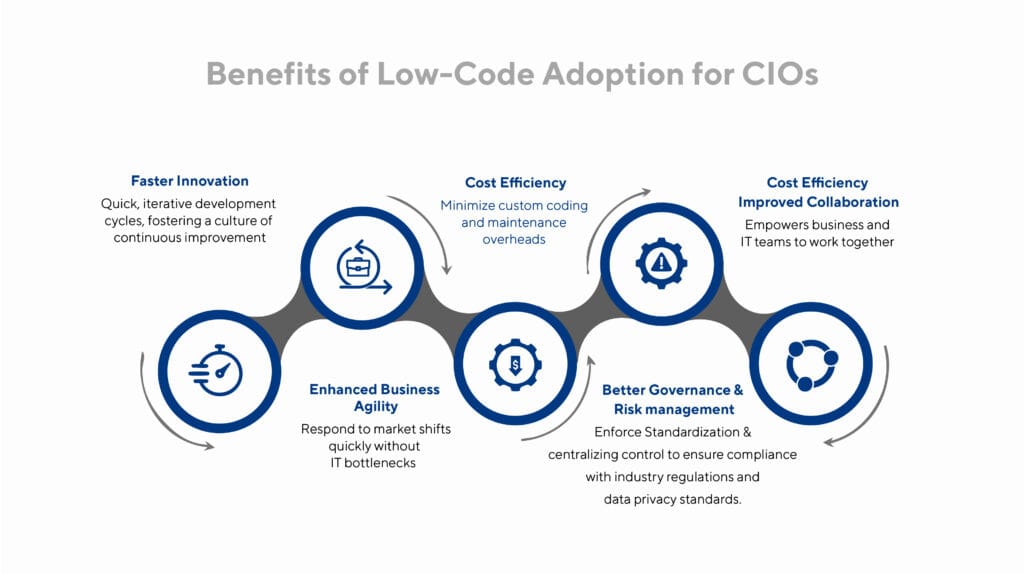CIOs are no longer just responsible for managing IT infrastructure—they are now strategic enablers of digital transformation. As enterprises face growing market disruptions, evolving customer expectations, and increasing operational complexities, low-code platforms are fast emerging as a critical tool for modernizing IT operations.
By 2025, 70% of new applications developed by organizations will utilize low-code or no-code technologies, up from less than 25% in 2020, according to Gartner.
This rapid adoption is a sign that more enterprises will shift toward faster, more agile solutions and low-code will be one of the primary platforms enabling it.
Traditional software development is often too slow and expensive, hindering business agility. Low-code platforms provide alternative enabling CIOs to rapidly build, deploy, and scale digital solutions with flexibility. With visual application development, automation, and seamless integrations, low-code empowers CIOs to drive operational efficiency, staff productivity, reduce technical debt, and future-proof their organization’s growth.
The Need to Explore New Operating Models
Business Complexity is Increasing
CIOs must manage multi-cloud environments, hybrid workforces, regulatory requirements, and cybersecurity threats, all while ensuring business agility. Traditional application development models lack the flexibility to adapt quickly to new business demands.
Legacy Systems Are Holding Back Innovation
Many enterprises still rely on outdated legacy systems, making it difficult to integrate AI, IoT, and automation. These rigid systems slow down digital transformation and require high maintenance costs.
Faster Innovation is a Competitive Advantage
Modern enterprises demand faster go-to-market solutions. Waiting months to develop custom applications is no longer feasible. CIOs need agile, low-code platforms to rapidly build, test, and deploy new applications.

How Low-Code Enables CIOs to Build New Operating Models
Accelerating Digital Transformation with a Structured Approach
Low-code enables CIOs to accelerate digital transformation without the complexity of traditional development. They can leverage platforms that offer a structured approach to low-code application development and make the app development process more efficient.
Ideate: CIOs and business leaders can brainstorm and collaborate effortlessly, mapping business needs to real-world applications.
Design: Visual & dynamic workflow builders allow teams to create applications without extensive coding.
Build: Pre-built templates, drag-and-drop elements, and automation tools reduce development time nearly by 10x.
Deploy: Applications can be launched seamlessly across cloud, on-premise, or hybrid environments.
Scale: With modular architecture and elastic infrastructure, CIOs can expand applications without investing in rewriting code effort of their app dev teams.
Low-code app development significantly benefits CIOs by enabling rapid progression from ideation to deployment. This methodology is ideal for continuous innovation, operational efficiency, and long-term business agility.
Enhancing Scalability & Flexibility
Scalability is critical for enterprise IT teams, especially in high-growth sectors like finance, healthcare, retail, and manufacturing. Low-code platforms provide key low-code advantages, including:
- Integrating low-code framework with existing ERPs, CRMs, and cloud services.
- Use real-time insights to continue updating applications with changing market and enterprise demands
- Add new features to the application without disrupting existing design using modular architecture feature.
With low-code, CIOs no longer need to choose between speed and stability—they get both.
Driving Data-Driven Decision-Making
Enterprise success hinges on real-time insights and predictive analytics, which are crucial for informed decision-making. Low-code platforms offer pre-built visual tools for automated data collection and visualization through interactive dashboards. These data- driven insights help CIOs in identifying inefficiencies & bottlenecks in workflows using predictive analytics and making faster, more informed decisions. By leveraging low-code solutions, CIOs can continuously optimize business operations and enhance service delivery, driving ongoing growth and efficiency.
Strengthening Security & Compliance
Low-code platforms enable CIOs to strengthen security and compliance by embedding regulatory controls directly into workflows. Modern, cutting-edge low-code enterprise solutions also come with role-based access control, built-in data security tools, audit trails, and reporting features, ensuring data privacy and efficient tracking of changes. These features help CIOs and digital transformation officers address the key challenge of quickly adapting to new as well as ever evolving industry regulations, eliminating the need for lengthy system overhauls.
Optimizing IT Resource Management
According to a McKinsey report, IT is the second-largest area for businesses to address potential skill gaps after data science. The IT skill gap poses a crucial challenge for CIOs and CTOs especially if they rely on traditional development methods. Low-code platforms empower cross-functional teams to collaborate, reducing dependency on specialized IT resources. This allows IT teams to focus on high-value tasks, while citizen developers manage routine application development, streamlining operations and increasing efficiency.
Conclusion
CIOs must lead the charge in building future-ready enterprises, and low-code platforms provide the foundation for success. By leveraging iLeap’s model-driven app development framework, CIOs can guide their organizations into an era of continuous innovation, delivering high-performing applications in a fraction of the time compared to traditional app development approaches.
